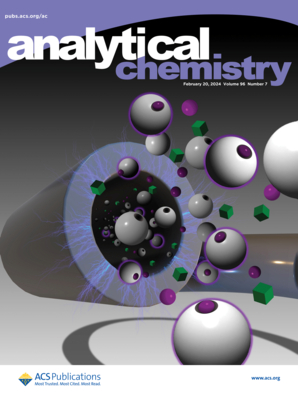Single-Molecule Protein Interactions and Unfolding Revealed by Plasmon-Enhanced Fluorescence.
IF 6.7
1区 化学
Q1 CHEMISTRY, ANALYTICAL
引用次数: 0
Abstract
Single-molecule characterization of protein interaction kinetics can unravel crucial mechanisms that are averaged out with ensemble-average approaches. However, current approaches based on single-molecule fluorescence are limited in terms of signal brightness and time resolution. We introduce a novel platform to quantify protein-protein interactions at the single-molecule level using plasmon-enhanced fluorescence microscopy. We illustrate the power of this approach using PDZ protein that is conjugated to plasmonic particles using a novel DNA-mediated hybridization method that provides spatial and orientational control over the proteins' immobilization. Single-molecule kinetic studies uncover heterogeneities in the interaction where a subpopulation of events exhibits a distinct bound-state-lifetime not observed before. This new method also enables the study of urea-mediated unfolding and refolding using binding kinetics as readout. The bound-state lifetime was found to be independent of urea concentration, implying a simple two-state unfolding model. In addition, we find that the folding is entirely reversible for the immobilized PDZ, in contrast to solution-phase unfolding that results in aggregation. Altogether, our results present single-molecule plasmon-enhanced fluorescence as a new and powerful method to monitor transient protein-protein interactions and protein folding on short time scales.等离子体增强荧光揭示的单分子蛋白质相互作用和展开。
蛋白质相互作用动力学的单分子表征可以揭示用集合平均方法平均出来的关键机制。然而,目前基于单分子荧光的方法在信号亮度和时间分辨率方面受到限制。我们介绍了一种新的平台,在单分子水平上使用等离子体增强荧光显微镜来量化蛋白质-蛋白质相互作用。我们使用一种新的dna介导的杂交方法将PDZ蛋白偶联到等离子体粒子上,该方法提供了对蛋白质固定化的空间和方向控制。单分子动力学研究揭示了相互作用的异质性,其中事件亚群表现出以前未观察到的明显的束缚态寿命。这种新方法还可以使用结合动力学作为读数来研究尿素介导的展开和再折叠。发现结合态寿命与尿素浓度无关,这意味着一个简单的两态展开模型。此外,我们发现固定PDZ的折叠是完全可逆的,而不是溶液相展开导致聚集。总之,我们的研究结果表明,单分子等离子体增强荧光作为一种在短时间尺度上监测瞬时蛋白质相互作用和蛋白质折叠的新而有力的方法。
本文章由计算机程序翻译,如有差异,请以英文原文为准。
求助全文
约1分钟内获得全文
求助全文
来源期刊

Analytical Chemistry
化学-分析化学
CiteScore
12.10
自引率
12.20%
发文量
1949
审稿时长
1.4 months
期刊介绍:
Analytical Chemistry, a peer-reviewed research journal, focuses on disseminating new and original knowledge across all branches of analytical chemistry. Fundamental articles may explore general principles of chemical measurement science and need not directly address existing or potential analytical methodology. They can be entirely theoretical or report experimental results. Contributions may cover various phases of analytical operations, including sampling, bioanalysis, electrochemistry, mass spectrometry, microscale and nanoscale systems, environmental analysis, separations, spectroscopy, chemical reactions and selectivity, instrumentation, imaging, surface analysis, and data processing. Papers discussing known analytical methods should present a significant, original application of the method, a notable improvement, or results on an important analyte.
 求助内容:
求助内容: 应助结果提醒方式:
应助结果提醒方式:


